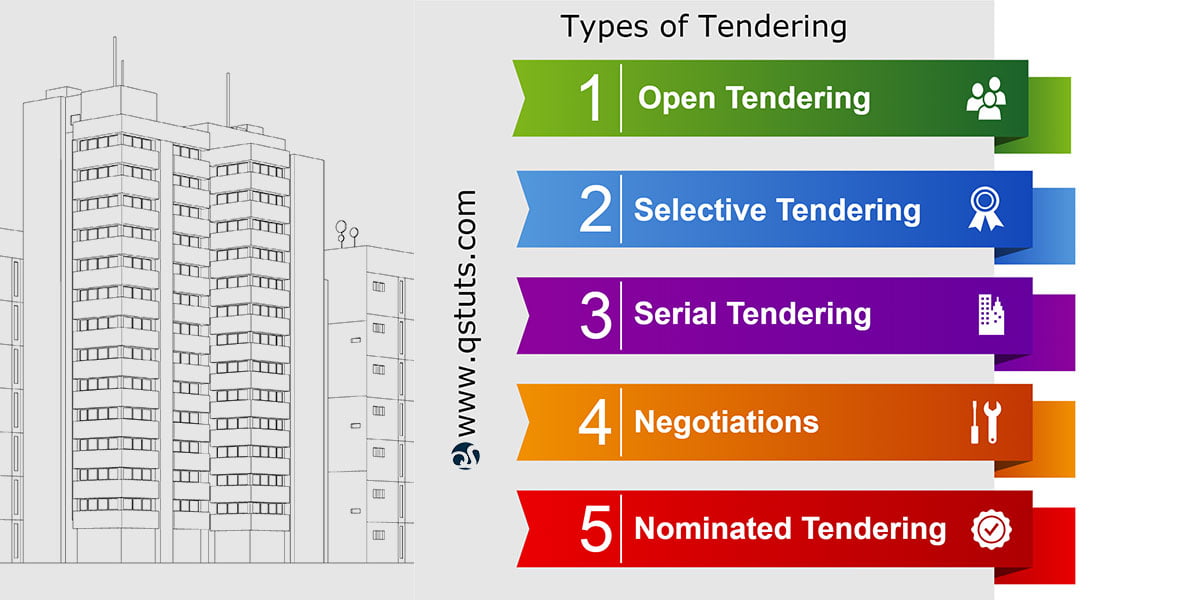What is Tendering or Bidding?
Tendering is the procedure of obtaining bids from prospective suppliers and assessing and picking the successful bidder to award the contract. Therefore, types of tendering can be used to find the most suitable contractor for the project, whether it is large or small. Tendering is advantageous in many ways, and is often implemented in both the public and private sector to ensure accountability and transparency in the selection process.
Many types of tendering are available, and they can be used for any project that involves the obtaining of services, goods or materials. It is a great way to ensure that the selection process is fair and efficient. Tendering also provides a platform for competition, as it allows for multiple suppliers to bid for the same job.
In addition, tendering also offers the ability to set criteria for selecting the most suitable supplier. This includes criteria such as cost, quality, delivery time, and more. This helps to ensure that the selection process is based on the most reliable data and information possible. Furthermore, tendering helps to ensure that the lowest price is offered for the project.
Overall, tendering is an important process for both the public and private sector, as it helps to ensure accountability and transparency in the selection process. It also provides a platform for competition, offers the ability to set criteria for selecting the most suitable supplier, and ensures that the lowest price is offered for the project.
Importance of Types of Tendering
It’s essential to choose the right contractor for a construction project. If the wrong decision is made, the client may be dissatisfied, the contractor may go bankrupt, and both parties could end up unhappy. So, it’s essential to select a contractor that is suitable for the job. Contractors usually work within a certain size or price range, and they usually won’t bid outside of that range.

When selecting a contractor, there are certain types of tendering in construction that should be taken into account.
- The business record of the Company has to be good.
- The company should be financially stable.
- The size of the project has to be under the company price range.
- The company should have a reputation for working in good quality and efficiency.
- The company has a good track record of construction industry relations.
It’s important to consider what makes for a better-contacting company in terms of quality, reliability, and cost. Ultimately, the goal is to choose a contractor who can deliver a successful project.
Furthermore, it’s important to research the contractor’s experience and track record. This can help to ensure that the contractor is reliable and has the necessary experience to handle the project. It’s also important to get references from the contractor, so you can hear first-hand accounts of their work.
Lastly, you should strive to develop a good relationship with the contractor. Establishing good communication and trust are key to ensuring that all parties involved in the project are satisfied. By taking these steps, you can be confident that you have found the right contractor for the job.
Tendering Process
Brief Introduction of Tendering Process in construction
Tendering is the process of inviting tenders from prospective contractors and suppliers for the construction of a project. It is a competitive process whereby potential contractors and suppliers submit bids for the work to be carried out. The tendering process can involve the evaluation of multiple bids from a range of contractors and suppliers in order to determine the best value for money. The tendering process typically involves the following steps:
Prequalification: Potential contractors and suppliers are prequalified to ensure they meet the necessary criteria.
- Request for Proposal (RFP): The project owner issues an RFP that outlines the scope of work, budget and timeline.
- Bidding: Contractors and suppliers submit bids for the work. These bids are evaluated on criteria such as price, quality, experience, and references.
- Contract Award: The project owner selects the best bid and awards the contract to the successful bidder.
- Negotiation: The project owner and the successful bidder negotiate the terms of the contract.
- Contract Execution: The contract is signed and the project is executed according to the terms of the contract.
Read detailed article : Tendering Process in The Construction Industry.
What are The Types of Tendering?
-
- Open Tendering
- Selective Tendering
- Serial Tendering
- Negotiations
- Nominated Tendering
You can download the Types of Tendering – Diagram as a PDF.
Open Tendering
This type of tendering is quite common in government projects, as the client openly invites bids for a certain project, without any restrictions. This is usually done with a newspaper notice or gazette notice. To avoid unnecessary applications, a refundable tender deposit or a tender bond may be requested. All deposits are refunded or bonds are released upon the submission of a valid tender.
In this process, all the bidders have the same chance to apply, ensuring fairness. As a result, this tendering method is highly sought after by clients, as it allows them to choose the most suitable bidder. Moreover, the transparency of this tendering procedure is highly appreciated.
Overall, this tendering method is a great way for clients to get the best deal for their project. It is simple, straightforward, and beneficial to both the client and the bidder. The client can get the best offer, while the bidder can get a chance to win the bid.
Advantages of Open Tendering
- There is no bias or favoritism,
- Offering newcomers a chance to participate,
- Capable contractors can also benefit from these opportunities,
- As the high competition ensures the client receives the highest quality of service,
- This competitive atmosphere also ensures the client can enjoy the maximum benefits available.
Disadvantages of Open Tendering
- With the large number of bidders, the cost of the tendering process can be rather high.
- Additionally, the process is quite time-consuming.
- Furthermore, due to the open opportunities, less experienced contractors may also bid.
Selective (Competitive) Tendering
The open tendering method has some drawbacks, but these have been alleviated in this Selective (Competitive) Tendering. In the industry, the type of tendering method is known as either Single Stage or Two-Stage Tendering. Let’s explore these two different types of tendering.
Both Single Stage and Two-Stage Tendering have their own benefits and drawbacks. It is important to assess the situation carefully before deciding which method is best for you.
Single Stage Tendering
The client and consultant will collaborate to shortlist potential tenderers. From the chosen applicants, they will collect bids. This type of tendering could involve up to eight different bidders. This is a straightforward way to ensure that the client and consultant are getting the right amount of bids.
Advantages of Single Stage Tendering
- Bidding is limited to experienced contractors, meaning there is greater assurance of quality work.
- This also cuts down on the time and money spent on tendering processes.
Disadvantages of Single Stage Tendering
- The lack of open tendering means there are fewer competitors, leading to reduced chances of getting the best deal.
- It also prevents newer, capable contractors from entering the market.
Two-Stage Tendering
In the initial step of the process, potential contractors will be carefully evaluated based on a variety of prequalification criteria, including past experience, resource capacity, and financial capability. Then, negotiations will commence with the chosen contractors, ultimately resulting in the awarding of the contract to the most advantageous bidder.
We’ll take a closer look at all of these documents, to ensure that everything is in order.
- The rates for the major components and detailed breakup,
- How the construction program is laid out
- what the allocated % for overheads and profits in the rates
- The basic rates of the preliminary items and detailed breakup
- Any prior qualifications and finances
Serial Tendering
Serial Tendering is a process used for big and complicated projects that include multiple construction phases. The tendering begins with the completion of designs and specifications for the first phase. It is then followed by a selective competitive tendering and negotiation process to select the contractor for this phase.
While the first phase is being built, the designs and specifications for the other phases are completed. Negotiations are then carried out to select the contractors for the extended phases. The first contractor is given priority in the negotiations as they are already mobilized to the site, allowing them to make a more competitive offer and saving the client money on mobilization costs.
This type of tendering is advantageous for large and complex projects because it offers the client the opportunity to save costs and ensures the project is completed with the highest quality of work. It is also a beneficial process for the contractor as it allows them to build relationships with the client, which may lead to further opportunities in the future.
Advantages and Disadvantages of Serial tendering
- One of the primary issues with serial tendering is that it can lead to a lack of competitiveness from the client. (Serial tendering can be a difficult process to manage)
- Additionally, if the markups are too high, the process can be prolonged, which can be a major drawback.
Read More : Master Guide 101: Serial Tendering In Construction
Negotiations
Negotiated projects are a great option for both the employer and contractor. This type of tendering choice is usually selected for specialized works, refurbishment, or extension projects. It involves the employer directly inviting one or two contractors of their choice to provide bids, followed by negotiations based on those proposals.
The benefit of this approach is that it takes into account any previous working experience and relationships that may have been established. This allows for a more satisfactory outcome for both parties and allows negotiations to be conducted more easily.
Negotiated projects provide a great way for employers and contractors to come to an agreement. Through the use of direct invitations and negotiations, both parties can ensure that their needs are met and that a satisfactory result is achieved.
Advantages of Negotiations
- Clients have the advantage of getting a favorable rate, without having to go through a long tender process.
- It’s a time-saver.
Disadvantages of Negotiations
- Disadvantages of Negotiations
It’s not ideal for everyone, particularly the public sector. - Newcomers are at a disadvantage.
- Favoritism is a real problem. The contractor can manipulate market prices to their advantage.
Nominated Tendering
Nominated Tendering is quite common when it comes to specialized works, refurbishment and expansion projects. This type of tendering is mainly due to the lack of competition which can lead to contractors offering higher prices. However, the invitation is still dependent on the excellent relationship between the contractor and client. It is important to ensure that the contractor is reliable, trustworthy and capable of delivering the required services. This will help to ensure that the project is completed in a timely and satisfactory manner.
Advantages of Nominated Tendering
- Nominated tendering can create a long-term relationship with a contractor, enabling them to become familiar with the business, its requirements, and its preferences.
- It reduces the costs associated with the tendering process, as the selection and evaluation process is more straightforward.
- It can be a useful tool for public sector organisations, allowing them to work with the same contractor on multiple projects and to ensure that they are meeting their contractual obligations.
- It allows for a more tailored approach to the tendering process, ensuring that the right contractor is chosen for the right job.
Disadvantages of Nominated Tendering
- It may lead to a lack of competition, as only one contractor is chosen. This could lead to higher prices and a lack of innovation.
- It can create a conflict of interest, as the contractor’s main motivation could be profit rather than providing the best service or product.
- It reduces transparency, as the selection and evaluation process is not open to the public.
- It can lead to a lack of accountability, as there is no guarantee that the chosen contractor will deliver the required service or product.








Good note would like to print